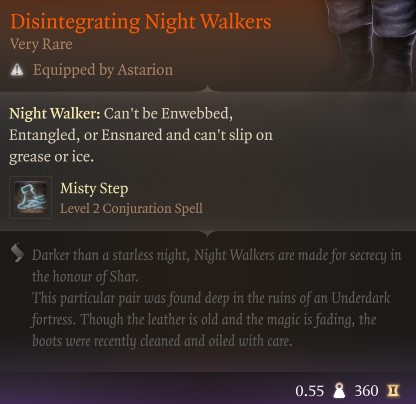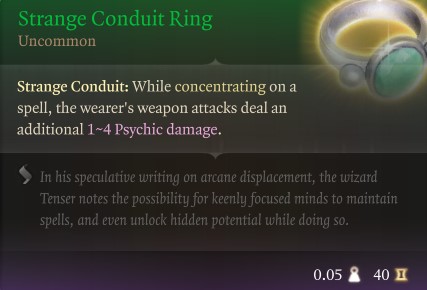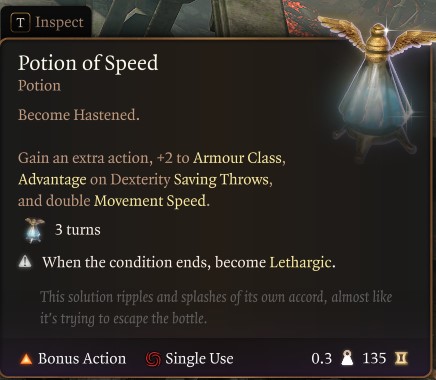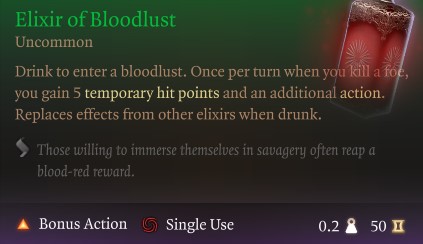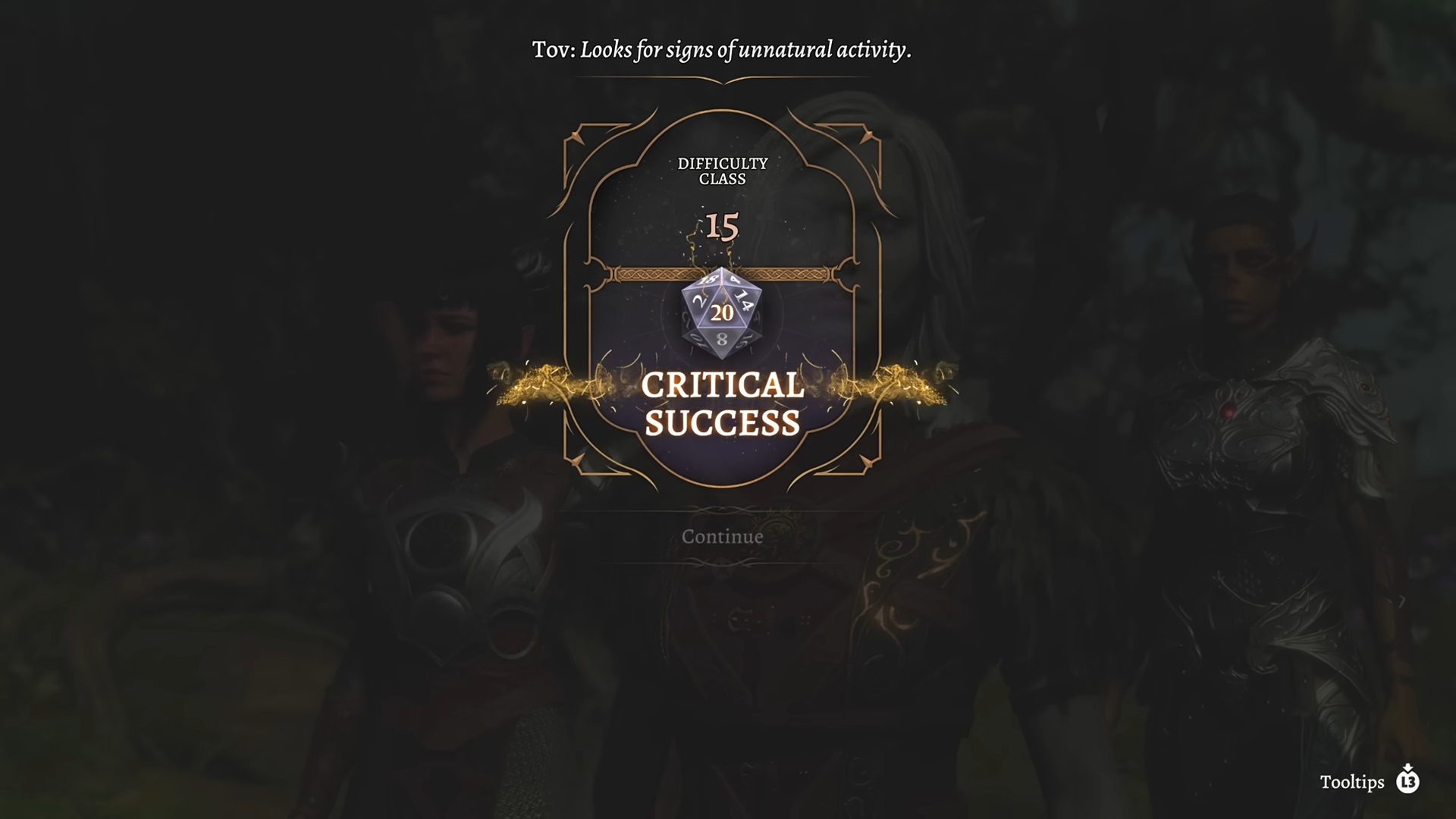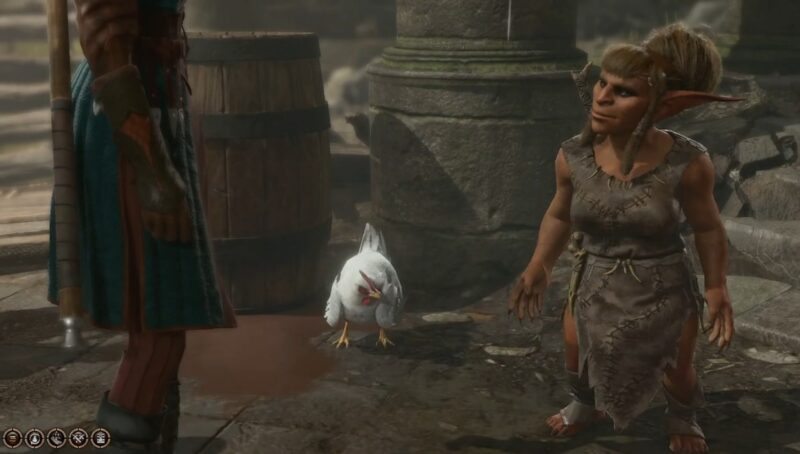This guide focuses on the essential aspects of a Bladesinging Wizard build in Baldur’s Gate 3 (BG3) and how to use those powers to your advantage.
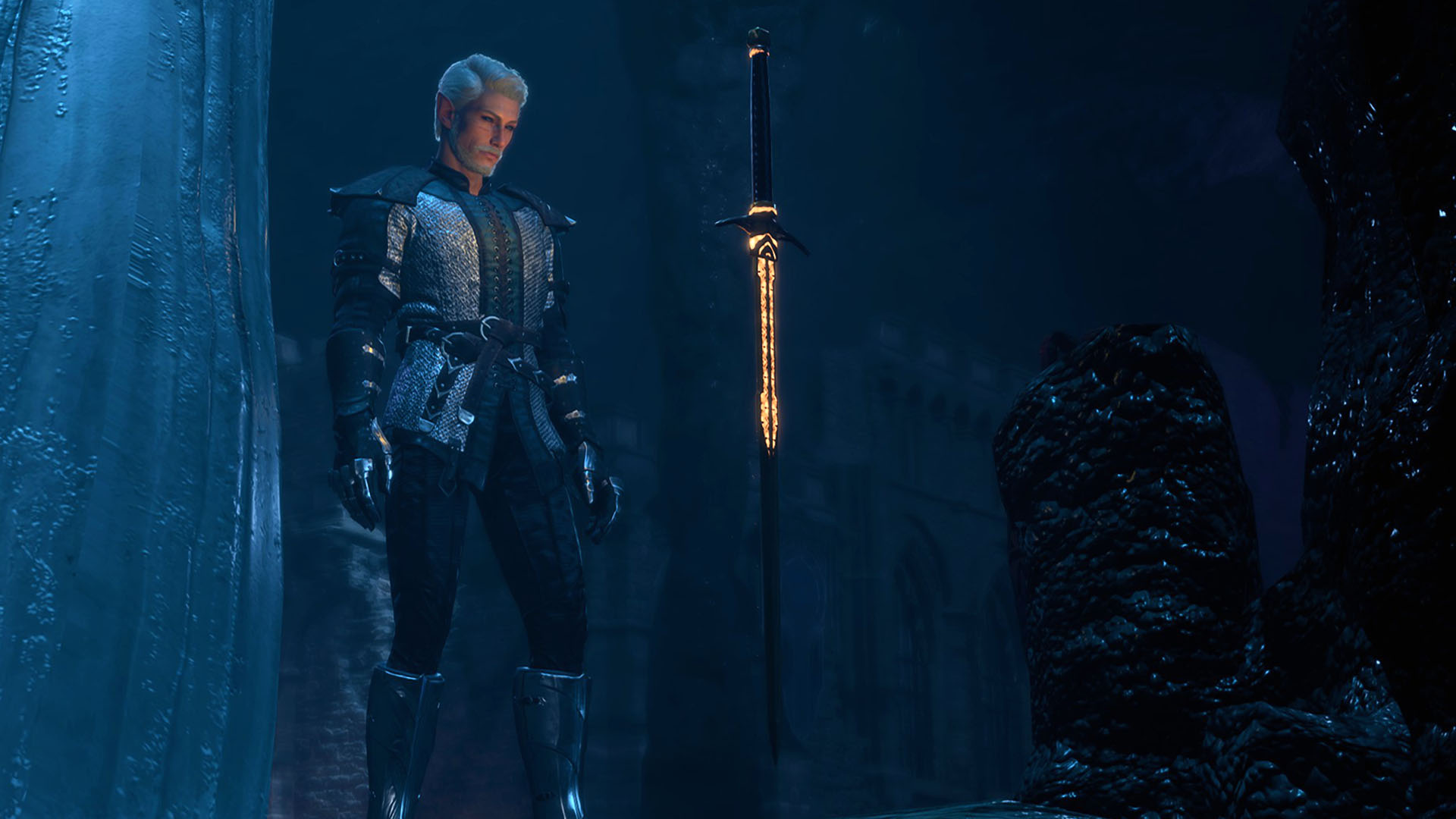
In Baldur’s Gate 3, creating a build can be a complex task. With things like ability score, level progression, companions, weapons, armor, and consumables, there are many variables for players to choose from. In this guide, we provide a step-by-step suggestion for the Wizard and, specifically, the subclass Bladesinging, released in Patch 8.
This build page has been updated for the Patch 8 version of Baldur’s Gate 3.
Wizard Class Guide in BG3
The Wizard class is an intelligence-based class focused on ranged spell casting. The strength of the Wizard is the ability to learn spells from scrolls, and you can adjust your spellbook without respecing or a long rest. This gives the Wizard a wide range of spells and playstyles to choose from. While the Wizard is a typical range spellcaster, with the Bladesinging subclass, you can play a melee powerhouse and even gain the extra attack feature!
Patch 8 Changes to Wizard Build for BG3
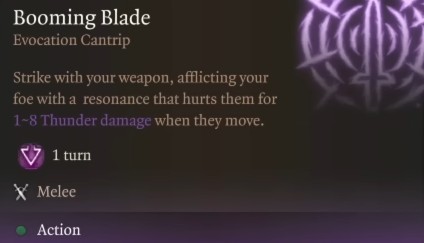
Patch 8 of Baldur’s Gate 3 brings major changes to the Wizard class with the introduction of the Bladesinging subclass and the Booming Blade cantrip, offering a fresh, melee-oriented playstyle. Bladesingers gain enhanced mobility, increased AC, and the ability to weave spells and swordplay together seamlessly. Booming Blade complements this by delivering reliable, scaling melee damage, encouraging a hit-and-move combat approach. This reimagines the Wizard as a swift frontline skirmisher, though it comes with a trade-off of reduced focus on high-level spellcasting and utility compared to more traditional builds.
To further enhance this agile combat style, a one-level dip into Hexblade Warlock adds even more value. This multiclass grants proficiencies in medium armor, shields, and martial weapons, significantly boosting early-game survivability. It also unlocks Eldritch Blast, giving you a powerful ranged option to complement your melee capabilities. While you do forgo an additional feat at Level 12 due to multiclassing, the early power spike, improved defenses, and overall versatility make this hybrid build both effective and rewarding throughout the game. Whether you’re charging into combat or casting from range, this setup gives your Wizard a dynamic and engaging edge.
Why you should choose the Bladesinging Subclass for Wizard Class in BG3?
You should pick the Bladesinging subclass for the Wizard if you want to play a melee spellcaster with Extra Attack. At level 6, the Wizard will attack twice with one action, similar to the Fighter, Ranger, Paladin, and Barbarian. Moreover, this subclass can use a spell, Shadow Blade, and stack strength as their ability score. The spell scales in effectiveness off of strength, thus giving you all the wide variety in spells from the Wizard, but with the burst in melee.
Everything About the Bladesinging Wizard in Baldur’s Gate 3
What makes the Bladesinging Wizard unique is its Extra Attack feature at level 6. Moreover, the Bladesinging Wizard gains light armour and additional weapon proficiencies, making it an actual melee subclass. With high damage, versatility in combat, and a variety of spells, the Bladesinging Wizard is one of the best in BG3.
However, the subclass can start off slow because you need to multiclass to gain extra armor proficiencies. Moreover, you gain an extra attack at level 6, not level 5 like other classes. Therefore, it will take a bit longer to see your raw power spike, but hang in there; it’s worth it!
| Bladesinging Wizard Build Pros | Bladesinging Wizard Build Pros |
|---|---|
| High Burst Damage | Slow Start |
| Wide Variety in Spells | Multiclass Needed |
| Flexibility in Combat | Complex |
Features and Mechanics of Bladesinging Wizard
The following list presents all the essential Bladesinging Wizard build Mechanics and Features in Baldur’s Gate 3:
- Class: Wizard
- Subclass: Bladesinging
- Background: Sage
- Skills: Investigation and Religion
- Ability Score
- Strength: 8
- Dexterity: 16
- Constitution: 14
- Intelligence: 17
- Wisdom: 8
- Charisma: 10
- Saving Throw: Intelligence, Wisdom
- Armour Proficiency: None
- Weapon Proficiency: Quarterstaves, Light Crossbows, Dagger
Related:
Character Creation
| Category | Selection |
|---|---|
| Character | Origin – Custom character |
| Race | High Half-Elf |
| Racial Bonus | Elven Weapon Training, Fey Ancestry, Darkvision, Cantrip |
| Class | Wizard |
| Subclass | Bladesinging |
| Cantrips | Fire Bolt, Booming Blade, Bursting Sinew, Friends |
| Spells | Longstrider, Magic Missile, Grease, Thunderwave, Chromatic Orb, Shield |
| Background | Sage |
| Ability Score | STR: 8 DEX: 16 CON: 14 INT: 17 WIS: 8 CHA: 10 |
| Skill Proficiencies | Investigation and Religion |
Race Choice for Bladesinging Wizard
High Half-Elf is the best race choice for a Bladesinging Wizard build because you gain shield proficiency, darkvision, and a free cantrip. Booming Blade is a helpful cantrip alongside Firebolt, giving you a one-two punch for melee or ranged damage at level one. You really need a race with Shield so consider that for optimal survival. The second choice is Human because of shield proficiencies and extra carry capacity. Lastly, we recommend Githyanki because of its mobility skills, such as Misty Step and Githyanki Psionics.
Here is the best race choice for a Bladesinging Wizard build in Baldur’s Gate 3:
| Race | Features |
|---|---|
| High Half-Elf | Civil Militia Fey Ancestry Darkvision Free Cantrip |
| Human | Civil Militia Extra Skill Proficiency |
| Githyanki | Astral Knowledge Githyanki Psionics Martial Prodigy |
Wizard Subclass – Bladesinging
The Bladesinging Wizard is unlocked at level 2. Once unlocked, the Wizard immediately gains light armor proficiency and additional weapons like a Longsword and Shortswords. By level two, the Wizard can equip a Longsword and Shield and play in Light armour with high dexterity. At level 6 is where your power spikes due to gaining extra attack feature, attacking twice with one action.
Below are the Bladesinging Wizard subclass features that become available while leveling up in Baldur’s Gate 3:
- Bladesong Power: 2 (level 2) Used to cast Bladesong. Replenished on a Long Rest.
- Bladesong (level 2): Invoke the Bladesong. You gain a +proficiency bonus to Armour Class and your movement speed increases by 3 meters. You also gain Advantage in Acrobatics and a +proficiency bonus to Constitution saving throws.
- Training in War and Song (level 2): You gain proficiency with Light Armour and in the Performance skill. You also gain proficiency with Daggers, Sickles, Shortswords, Rapiers, Scimitars, and Longswords.
- Bladesong Power: 3 Gain an additional use of Bladesong (level 5).
- Extra Attack (level 6): You can make an additional free attack after making an unarmed or weapon attack.
- Bladesong Power: 4 Gain an additional use of Bladesong (level 9).
- Song of Defence (level 10): When you take damage during your Bladesong, you can expend a spell slot to subtract 5 damage per spell slot.
Recommended Background for Bladesinging Wizard
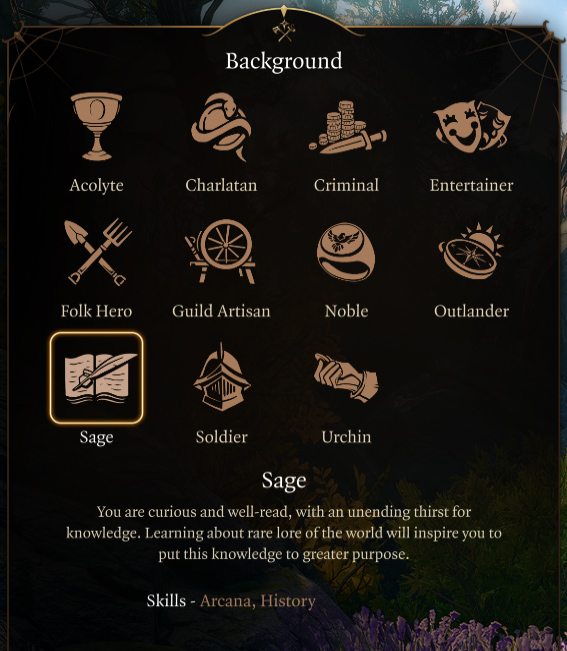
Sage is the best background for the Bladesinging Wizard Build because you gain two intelligence-based skills. Below are the recommended backgrounds for the Bladesinging Wizard build:
- Sage: Proficiency in Arcana (intelligence) and History (intelligence). You are curious and well-read, with an unending thirst for knowledge. A companion who’s a Sage background is Gale.
- Noble: Proficiency in History (intelligence) and Persuasion (charisma). You were raised in a family among the social elite, accustomed to power and privilege. A noble companion is Minthara.
- Acolyte: Proficiency in Insight (wisdom) and Religion (intelligence). You have spent your life serving a temple, learning sacred rites, and providing sacrifices to the god or gods you worship. Shadowheart is an Acolyte.
Ability Score
The Best Ability Score for Bladesinging Wizard Build is 17 Intelligence, 16 Dexterity, and 14 Constitution. Intelligence influences your spellcasting success, while Dexterity determines your combat order and AC. Constitution is useful for higher health.
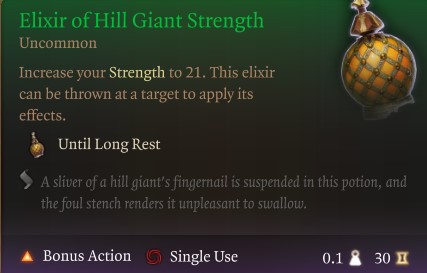
While the strength recommendation is low, we highly recommend using Elixir of Hill Giant Strength (Cloud Giant in Act 3). This gives you 21 strength until a long rest and drastically boosts the damage with Shadow Blade. Moreover, if you can’t craft these consistently, you can use the Club of Hill Giant Strength in your main hand, found in Act 1. Lastly, look to gain Auntie Ethel’s hair permanent bonus to increase your Intelligence to 18 (an even number).
Below is the best ability score for a Bladesinging Wizard in Baldur’s Gate 3:
| Ability | Recommended Score |
|---|---|
| Strength | 8 |
| Dexterity | 16 |
| Constitution | 14 |
| Intelligence | 17 |
| Wisdom | 8 |
| Charisma | 10 |
You can increase your ability score via a quest in Act 1, Act 2, and Act 3. Make sure to check out our Permanent bonus guide on how you can boost your ability score through quests.
Recommended Skills for Bladesinging Wizard
Investigation and Religion are the best skills for our Best Baldur’s Gate 3 Bladesinging Wizard Build Guide because they complement your class abilities and enhance your effectiveness in various situations. Depending on your background selection, you may select different choices. However, focus on intelligence based choices and have companions with other skills to compliment your party loadout.
Here are the best skills for Bladesinging in Baldur’s Gate 3:
- Investigation: is an Intelligence skill used to analyze clues and solve mysteries.
- Religion: is an Intelligence skill that helps recognize deities and holy rites.
Illithid Powers For Bladesinging Wizard
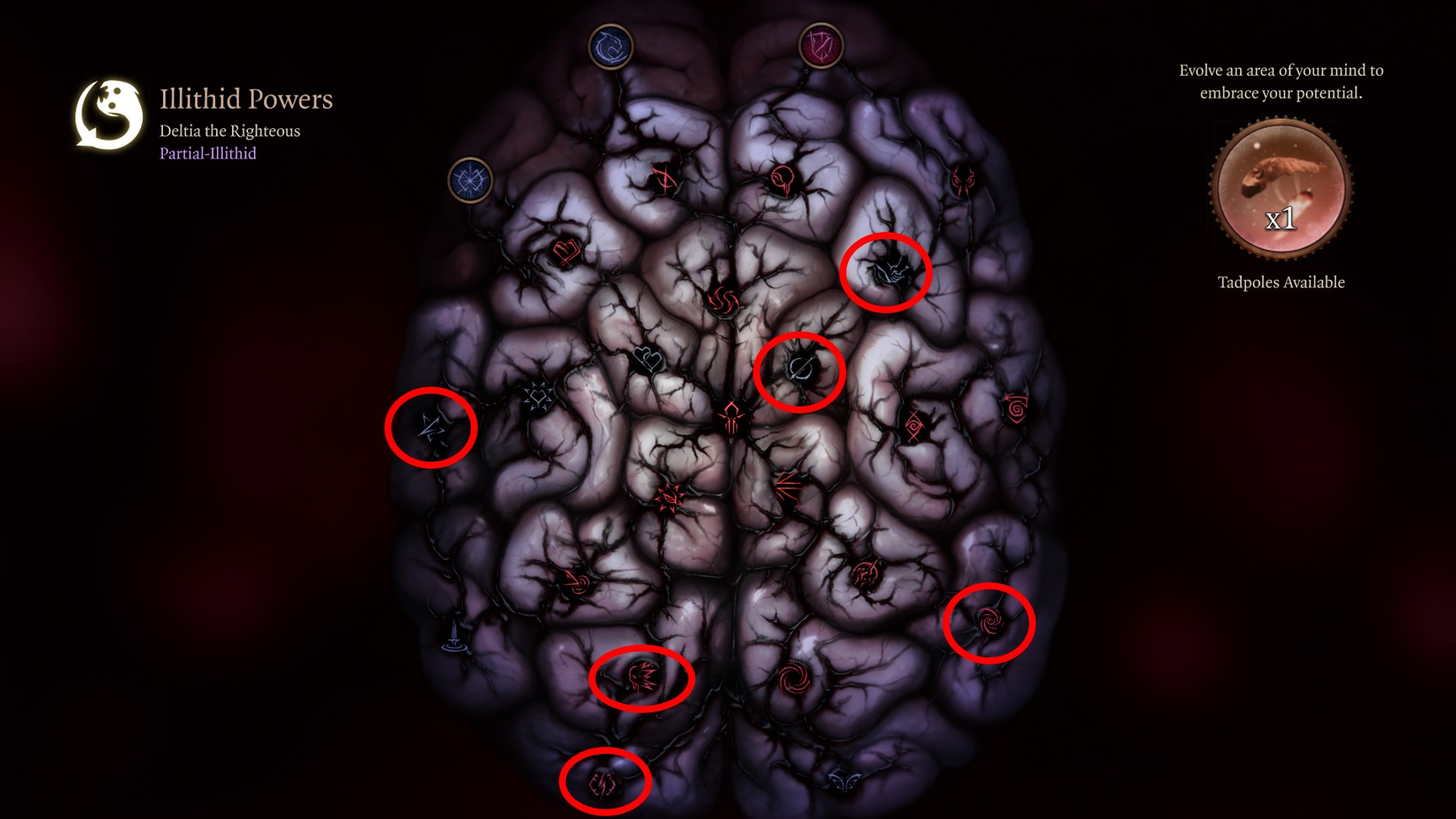
The best Illithid Powers for a Bladesinging build are Luck of the Farm Realms, Black Hole, and Cull of the Weak. Luck of the Farm helps with critical hits and burst damage and, combined with Cull of the Weak, can trigger AOE damage passively. Black Hole requires you to take the Astral Tadpole in Act 2, but it sucks in 5 enemies, slows them, and can be recast for free. This is helpful in certain large-scale boss fights with many enemies. Below are the best Illithid Tadpole Powers for the Bladesinging build in Baldur’s Gate 3:
| Illithid Powers | Description |
|---|---|
| Luck of the Far Realms | When you make a successful Attack Roll against a foe, you can change that hit into a Critical Hit. |
| Cull of the Weak | When you bring a creature down to fewer hit points than your number of evolved Illithid powers, it dies and all nearby creatures take 1-4 Psychic damage. |
| Psionic Backlash | When an enemy within 9m casts a spell, you can use your reaction to inflict ld4 Psychic damage to the caster per the spell’s level. |
| Blackhole | Area-based suck-in that slows targets. |
| Repulsor | Massive area knockback that can hit friendlies. |
| Charm | This is the priority power you want to obtain because you can force enemies to attack something else. |
Best Companions for Bladesinging Wizard
Shadowheart, Lae’zel, and Astarion make the best companions for the Bladesinging Wizard build because you gain healing, range damage, and lockpicking. Make sure to have one support, one ranged damage, and one utility companion. Below are our recommendations:
- Shadowheart (Life Cleric) – Utilize Shadowheart to buff, heal, and stun enemies.
- Lae’zel (Gloom Stalker Ranger) – Used for turn one kills and ranged damage.
- Astarion (Thief Rogue) – for lock-picking and stealth.
Related:
Best Bladesinging Wizard Build – Level Progression in Baldur’s Gate 3
| Level | Class | Selection |
|---|---|---|
| 1 | Wizard | Cantrips: Fire Bolt, Booming Blade, Bursting Sinew, Friends, Spells: Longstrider, Shield, Thunderwave, Magic Missile |
| 2 | Wizard | Subclass: Bladesinging, False Life, Feather Fall |
| 3 | Wizard | Shadow Blade, Misty Step |
| 4 | Wizard | Feat: Ability Improvement +2, Blur, Mirror Image |
| 5 | Wizard | Fireball, Counterspell |
| 6 | Wizard | Extra Attack, Darkness, Enlarge/Reduce |
| 7 | Paladin | Multiclass: Oath of Devotion Paladin |
| 8 | Paladin | Defence Fighting Style, Command, Thunderous Smite |
| 9 | Fighter | Multiclass: Fighter, Protection Fighting Style |
| 10 | Fighter | Action Surge |
| 11 | Fighter | Subclass: Champion |
| 12 | Fighter | Feat: Alert |
Alternative Bladesinging Wizard Build
For our alternative Wizard build, start at Level 1 by taking a level in Hexblade Warlock. This gives you early access to Eldritch Blast and Booming Blade—two highly impactful cantrips—as well as proficiencies in medium armor, shields, and martial weapons. These additions significantly improve your early-game durability and make frontline combat far more manageable. If you’d rather wear traditional robes, be sure to grab Mage Armour at Wizard Level 3 for a reliable defensive boost.
Although Bladesinging is the intended core of this guide, we recommend considering Evocation here instead for its strong synergy with offensive cantrips and area-of-effect spells. Evocation allows you to maximize damage while minimizing friendly fire, making it an excellent fit for a more aggressive playstyle. While you’ll lose a feat at Level 12 due to multiclassing, the early combat strength, enhanced survivability, and long-term value of your cantrips make the trade-off well worth it. This hybrid build blends versatility and firepower, offering a fun and effective way to approach combat from both the front line and a distance.
| Level | Class | Selection |
|---|---|---|
| 1 | Warlock | Subclass: Hexblade, Eldritch Blast, Booming Blade, Hex, Shield |
| 2 | Wizard | Firebolt, Mage Hand, Friends, Chromatic Orb, Magic Missile, Longstrider, Shield, Thunderwave, Find Familiar |
| 3 | Wizard | Subclass: Evocation, Mage Armour, Protection from Good and Evil |
| 4 | Wizard | Misty Step, Scorching Ray |
| 5 | Wizard | Bursting Sinew, Mirror Image, Blur, Feat: +2 Intelligence |
| 6 | Wizard | Fireball, Counterspell |
| 7 | Wizard | Haste, Glyph of Warding |
| 8 | Wizard | Conjure Minor Elemental, Ice Storm |
| 9 | Wizard | Banishment, Blight, Shocking Grasp, Feat: Spell Sniper |
| 10 | Wizard | Conjure Elemental, Cone of Cold |
| 11 | Wizard | Toll of the Dead, Hold Monster, Confusion |
| 12 | Wizard | Disintegration, Globe of Invulnerability |
Level 1
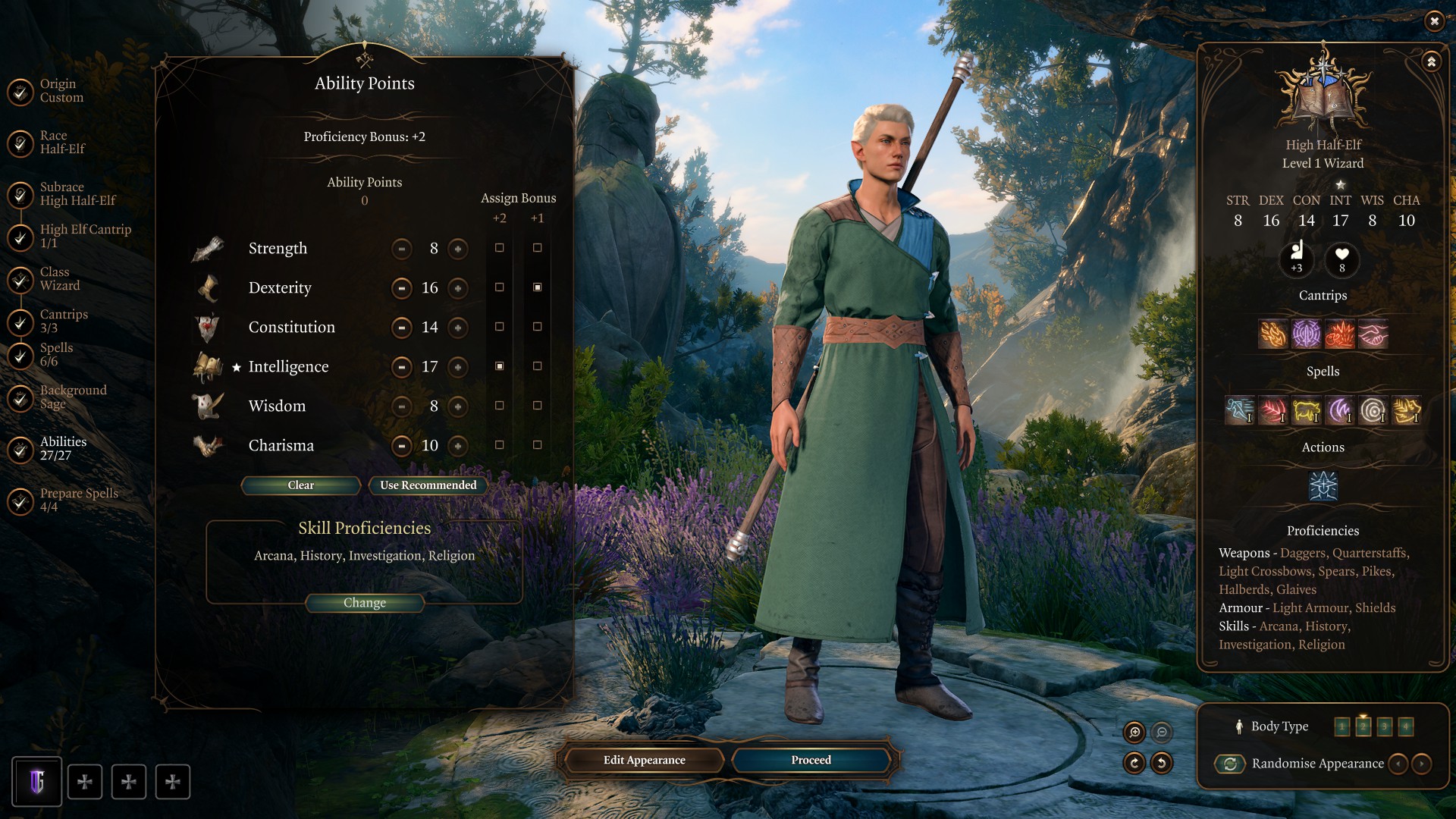
At level one, the Wizard makes many selections, and below is our recommendations:
Cantrip Selection
- Fire Bolt: Hurls fireball dealing 1d10 fire damage 18m range.
- Booming Blade: Scales off of weapon attack and strength, melee damage.
- Bursting Sinew: Explode a corpse, causing it to impale those around it, 1-10 piercing damage.
- Friends: Gain Advantage on Charisma Checks against a non-hostile creature.
Spell Selection
- Longstrider: Can pre-buff yourself and party for increased movement speed.
- Magic Missile: Create 3 darts of magical force, each dealing 1d4+1 Force to its target. The darts always hit their target.
- Grease: starter spell that is good for crowd control.
- Thunderwave: Release a wave of thunderous force that pushes away all creatures and objects (2d8 Thunder).
- Chromatic Orb: Hurl a sphere that deals 3-24 elemental damage and possibly creates a surface on impact.
- Shield: When you are about to be hit by an enemy, increase your Armour Class by 5 as a reaction.
Arcane Recovery: you can recover two spell slots. The number allows you to either restore two level 1 spells or one level 2 spell. It’s a simple mechanic that you can use to prevent endless Resting in between fights. Expect a lot of rest at lower levels where your spell slots are limited.
Bladesinging Wizard Level 1 Prepared Spells: Longstrider, Shield, Thunderwave, Magic Missile.
Gameplay Priorities at Level 1
At level 1, your main goal is to equip a one-handed weapon and shield. Use Firebolt and Magic Missile as your damage spells. If playing in range, you can attack with Booming Blade, but it won’t be effective until you have high strength with Hill Giant Strength.
At level 2, you gain access to light armour and more utility, so save spell slots and use cantrips if possible. Depending on your race, you may or may not be able to use a shield.
Level 2
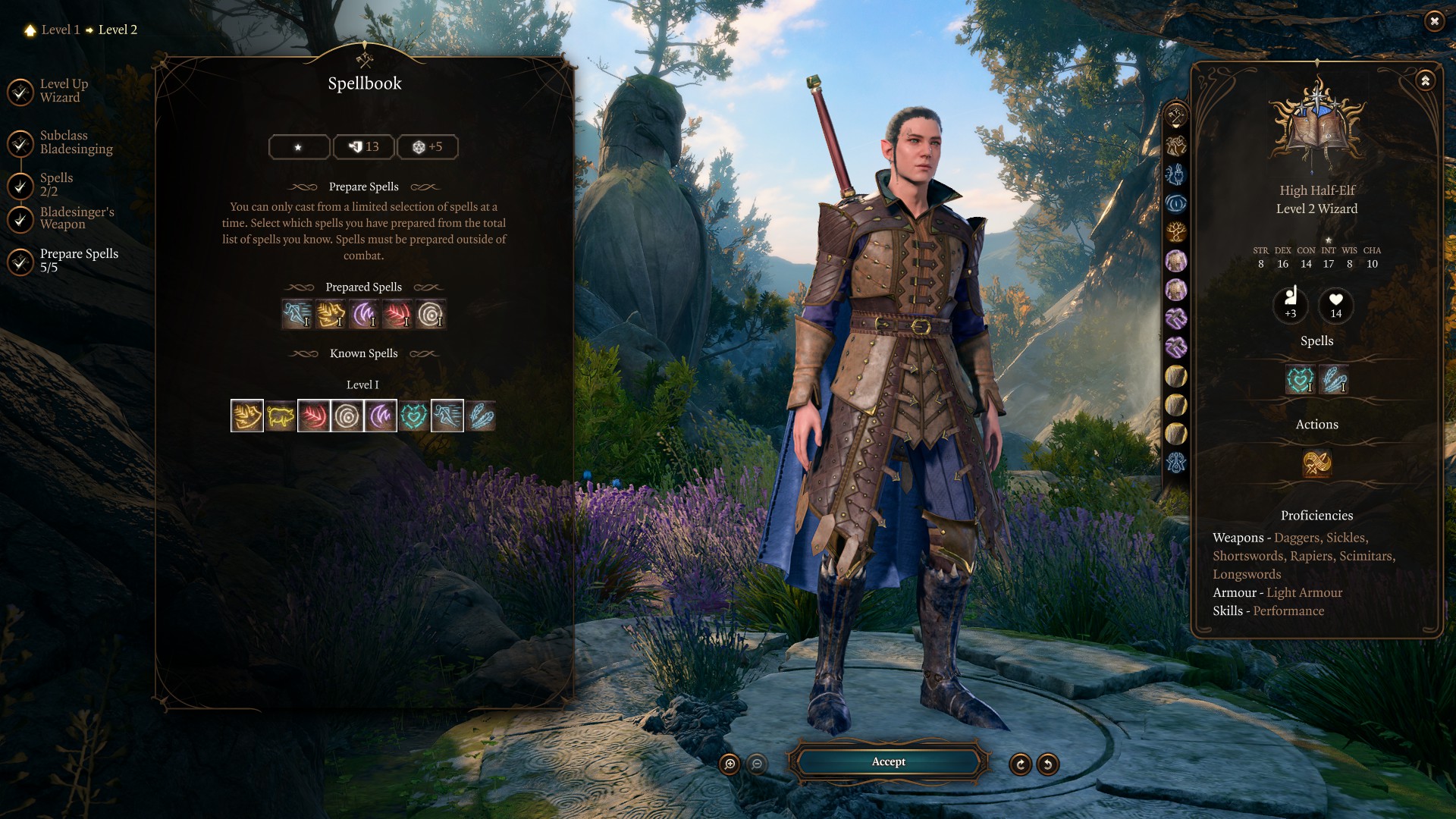
Level two Wizard picks their subclass (obviously, we will be choosing Bladesinging School here), gets two spells, and has 5 prepared spells.
- False Life (spell selection): Can use spell slot for more HP.
- Feather Fall (spell selection): Utility spell traveling in Act 1.
- Bladesong Power – 2: Used to cast Bladesong. Replenished after a Long Rest.
- Bladesong (subclass feature): You gain a +proficiency bonus to Armour Class and your movement speed increases by 3 meters. You also gain Advantage in Acrobatics and a +proficiency bonus to Constitution saving throws.
- Bladesong Climax: The finale of a Bladesinger wizard’s Bladesong. Your Bladesong Damage Charges will harm enemies an additional 1d6 Force damage, and your Bladesong Healing Charges will heal you and your allies an additional 1d6 hit points.
- Training in War and Song (subclass feature): You gain proficiency with Light Armour and in the Performance skill. You also gain proficiency with Daggers, Sickles, Shortswords, Rapiers, Scimitars, and Longswords.
- Bladesinging Weapon: Longsword (if you use Phalnar Aluve with High Elf Race, otherwise Shortsword).
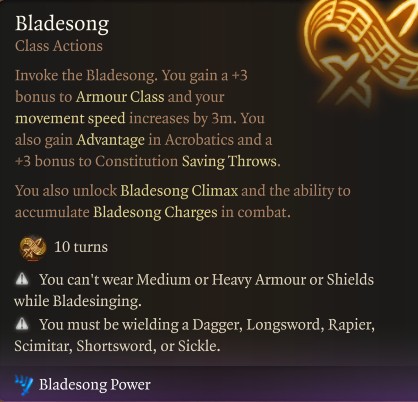
Bladesinging Wizard Level 2 Prepared Spells: Longstrider, Shield, Thunderwave, Magic Missile, Chromatic Orb.
At this level, your gameplay revolves around traditional Wizard ranged damage with a mix of melee using Booming Blade cantrip. Longstrider pre-buff for extra movement, save a spell slot for shield, and knock enemies back with Thunderwave. Use Magic Missile or Chromatic Orb for ranged damage you can now attack with the Bladesong power giving you extra force damage.
Level 3
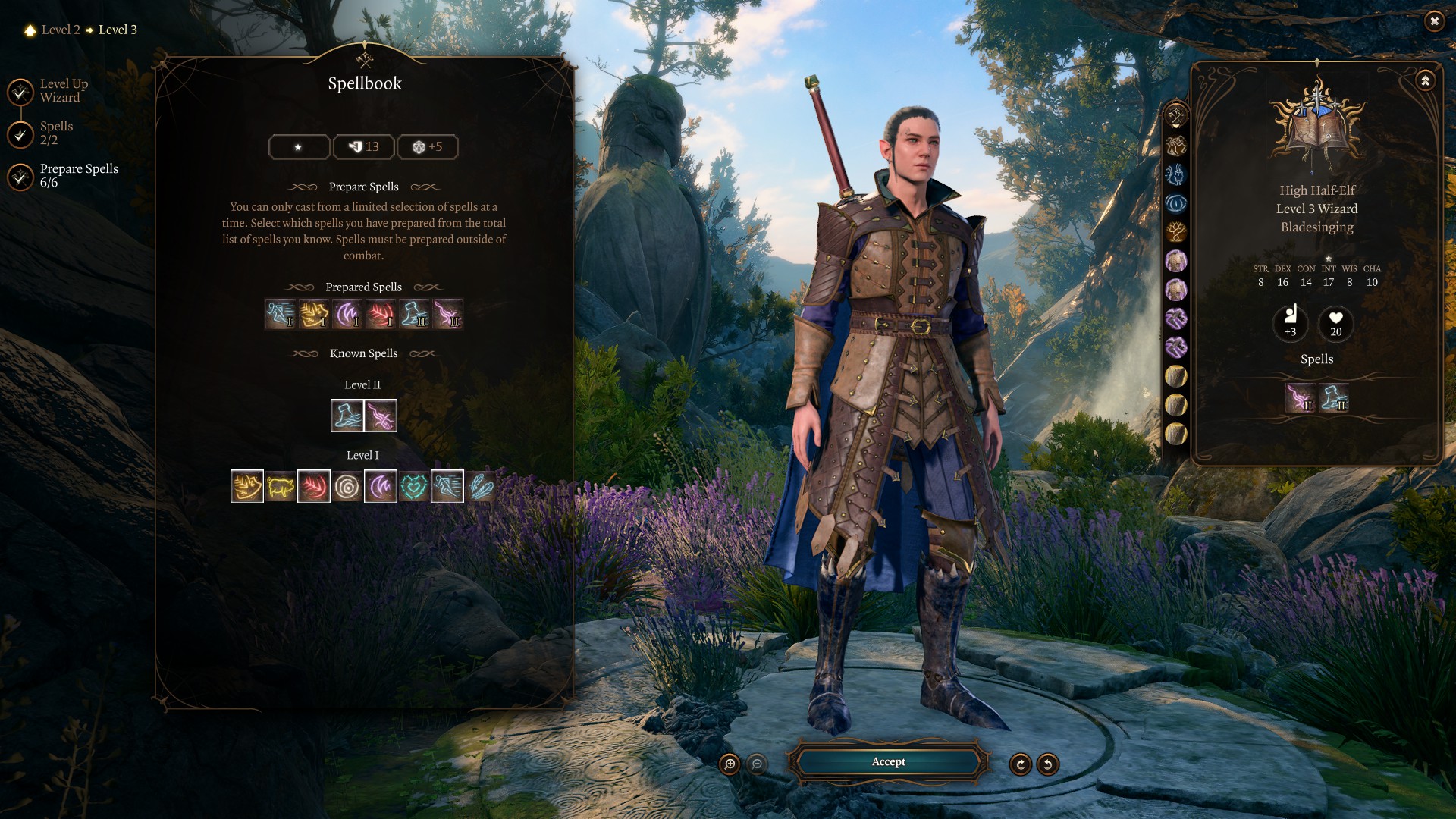
At Level 3, our Best Baldur’s Gate 3 Bladesinging Wizard Build Guide unlocks two level 2 spells and gets to select two new spells with a total of 6 prepared spells.
- Shadow Blade (spell selection): Summons a sword that requires concentration and attacks with Psychic damage.
- Misty Step (spell selection): This is an Essential mobility spell. However, take Mirror Image if you are playing solo or struggling with survival. Blur also stacks on top of this bonus if playing solo.
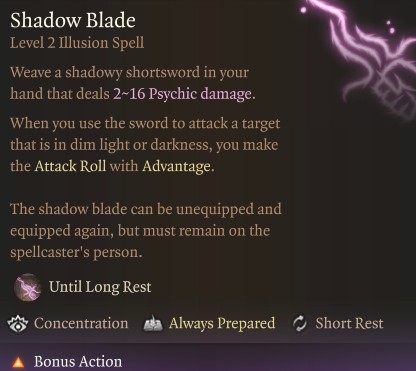
Bladesinging Wizard Level 3 Prepared Spells: Drop Chromatic Orb and slot both Misty Step and Shadow Blade.
Now that you have gained Shadow Blade, you can attack effectively in melee range in addition to Bladesong. Shadow Blade will cost a bonus action and last until long rest and require concentration. Therefore, don’t take too many concentration spells as you won’t be able to use them.
At this point, you want to use an Elixir of Hill Giant Strength and attack with Shadow Blade for the most damage in melee. The Resonace Stone, found in Act 2, can double the damage of this weapon, giving you a powerful combo for most of the game. You can also “upcast” the Shadow Blade to get more damage with it as you gain higher-level spells.
Level 4

At level 4, the Bladesinging Wizard unlocks 1 new cantrip, two spells, and your first feat. Below are our suggestions at level four:
- Minor Illusion (cantrip selection): Create an illusion that compels nearby creatures to investigate. You can remain hidden while casting this spell. This spell can be cast while you are Silenced.
- Blur (spell selection): Attackers have Disadvantage on Attack rolls against you.
- Mirror Image (spell selection): Create 3 illusory duplicates of yourself to distract attackers. Each duplicate increases your Armour Class by 3.
- Ability Improvement (feat selection): Intelligence + 2
Bladesinging Wizard Level 4 Prepared Spells: Longstrider, Shield, Thunderwave, Magic Missile, Chromatic Orb, Shadow Blade, Misty Step, Mirror Image
At this level, boost your intelligence and take two defensive spells Blur and Mirror Image. Blur won’t be that useful since you have concentration and may need to swap to another spell if you don’t use it. However, you can also have another party member cast it on you, in addition to casting mirror image on yourself (spell or scroll), for incredible survivability. If you struggle in melee range, pre-buff with these two spells and likely no enemy will hit you in Act 1.
Level 5

At level 5, our Best Baldur’s Gate 3 Bladesinging Wizard Build Guide unlocks two level 3 spell slots and selects two spells with other prepared spells. Below are our suggestions at level five:
- Bladesong – 3 (subclass feature): Gain an additional use of Bladesong.
- Fireball (spell selection): Shoot a bright flame from your fingers that explodes upon contact, torching everything in the vicinity 8d6 18m range 6m radius.
- Counterspell (spell selection): Nullify another creature’s spell as a reaction. The spell must be 3rd level or lower. If it is higher, you must succeed in a Check to nullify it, the difficulty of which is based on the spell’s Level.
Bladesinging Wizard Level 5 Prepared Spells: Longstrider, Shield, Thunderwave, Magic Missile, Chromatic Orb, Shadow Blade, Misty Step, Mirror Image, Fireball, Counterspell
At this level, we gain level 3 spell slots, counterspell, and Fireball. You can now play in melee or at range and have effective damage. However, you need one more level to gain extra attack.
Level 6
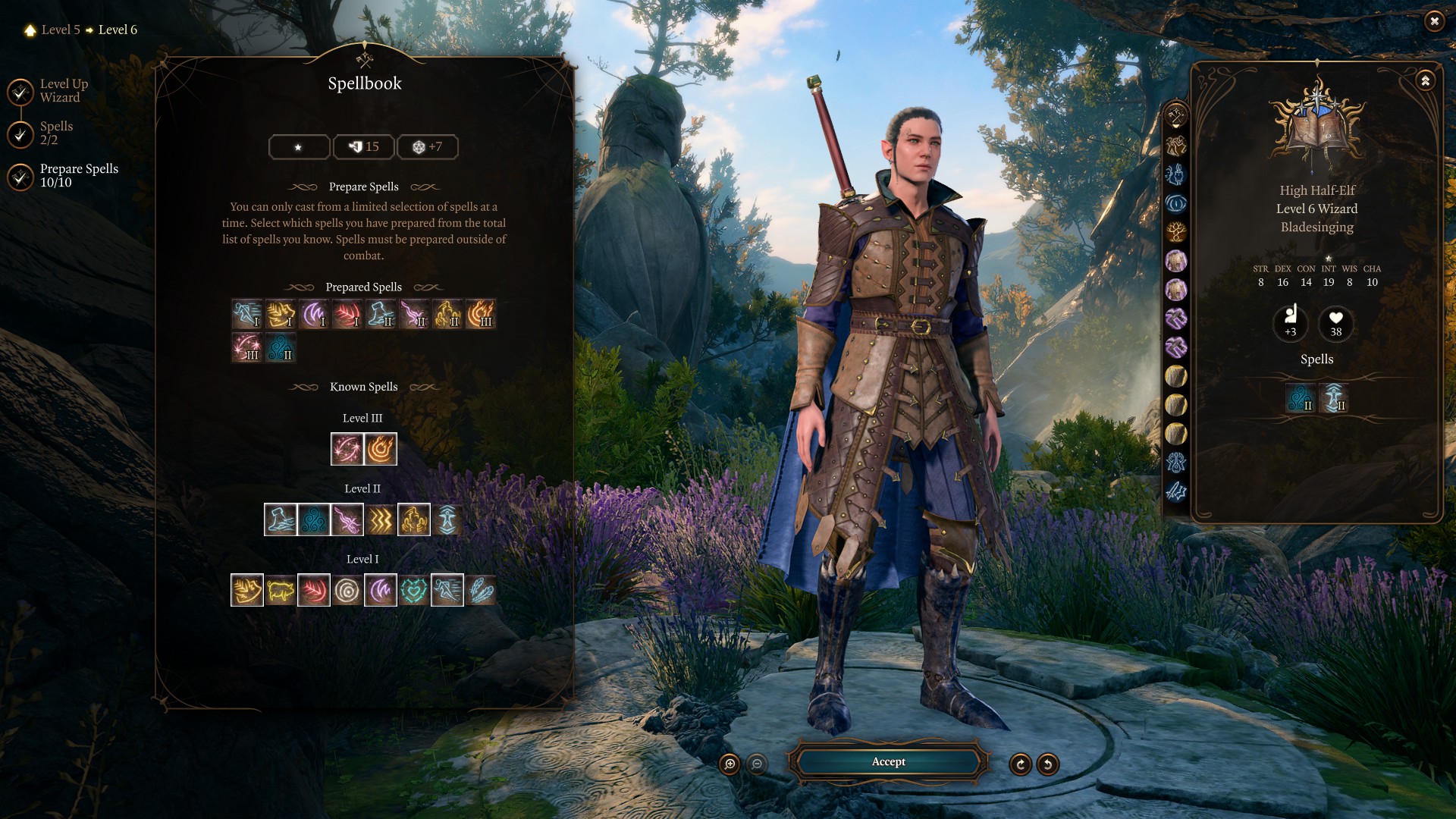
At level 6, the Bladesinging Wizard unlocks a subclass feature and selects two spells. Below are our suggestions at level six:
- Extra Attack (subclass feature): You can make an additional free attack after making an unarmed or weapon attack.
- Darkness (spell selection): Create a cloud of magical darkness that Heavily Obscures and inflicts Blind to creatures within.
- Enlarge/Reduce (spell selection): Make a creature larger or smaller to affect their weapon damage and Strength Checks and Saving Throws.
Darkness is helpful to blind all creatures in an area, and if you have the ring Eversight, you can still see while in the darkness. Additionally, Enlarge is helpful if you’re not using Shadow Blade or have a companion cast it on you because it requires concentration.
Now, beyond level 6, you can stay within the Wizard class which will gain you higher spell slots and more spells. But, for the most raw melee power, and extra armour and weapon choices, we suggest multiclassing to the Paladin.
Bladesinging Wizard Level 6 Prepared Spells: Longstrider, Shield, Thunderwave, Magic Missile, Chromatic Orb, Shadow Blade, Misty Step, Mirror Image, Fireball, Counterspell, Darkness
Level 7
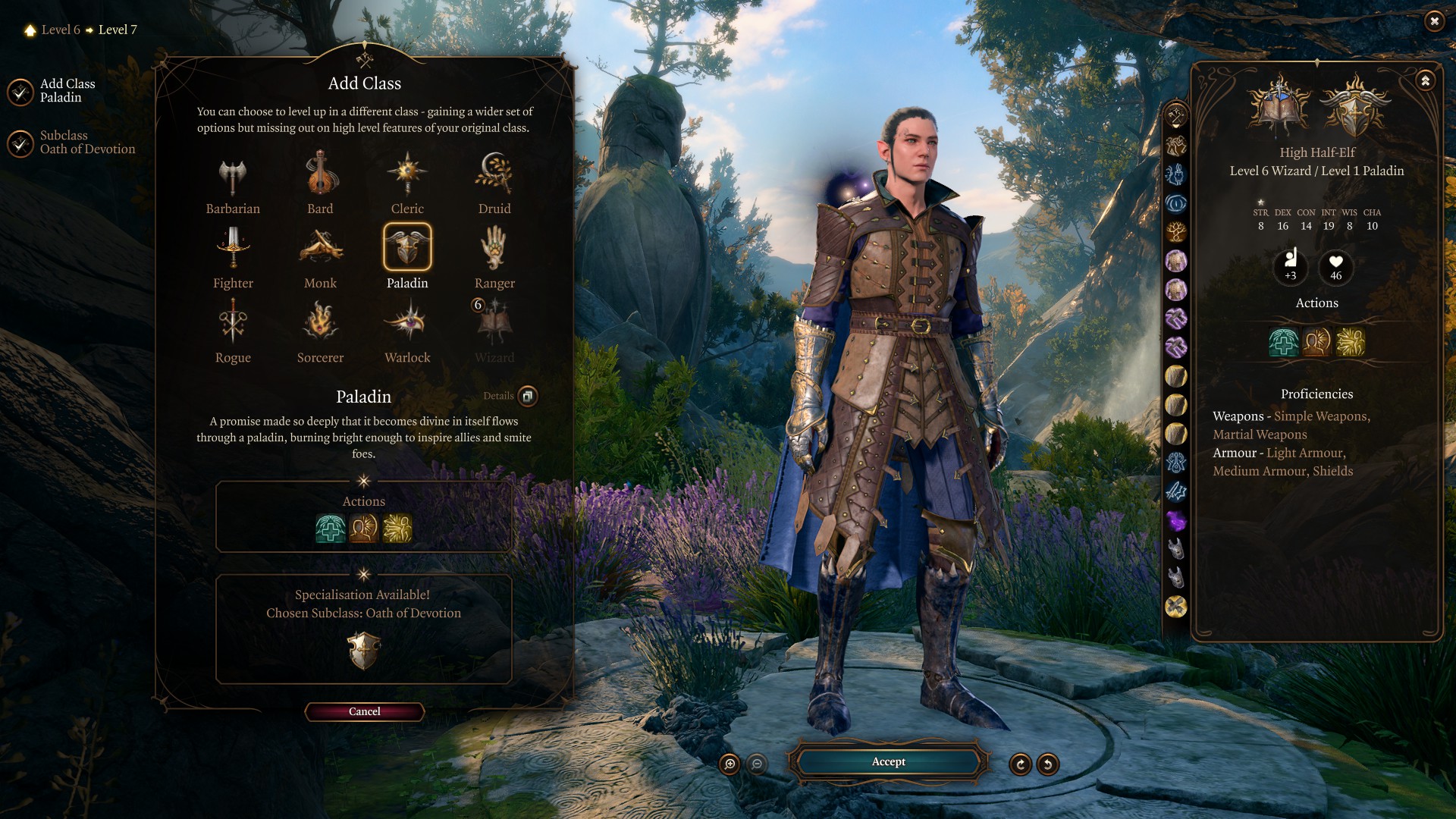
At level 7 our Best Baldur’s Gate 3 Bladesinging Wizard Build we’re going to start multiclassing, starting with the Paladin class. The reason this is helpful is using the Divine Smite spells with your melee attacks to trigger extra damage. However, this will make the build more complex and require more long rest, but give you the most amount of burst possible.
Additionally, at this level you gain Martial Weapon proficiency. Therefore, you can use a Two-Handed weapon greatsword and a Strength build like other melee. However, we recommend sticking to one hand and shield Shadow Blade and Shield for a balance of offense and defense.
Here’s a breakdown of what you get as a level 1 Paladin:
- Channeled Oath Charges: Paladin-specific resource that allows the casting of spells and abilities.
- Lay on Hands: Use your blessed touch to heal a creature or cure it of all diseases and poisons.
- Usage: Single target melee heal using action or cure disease. This consumes Oath Charges but is an effective heal.
- Divine Sense: Gain Advantage on Attack Rolls against celestials, fiends, and undead.
- Usage: This uses bonus action which can be used with an attack costing an action.
- Holy Rebuke: Grant an ally a vengeful aura that deals 1d4 Radiant damage to anyone who hits them with a melee attack (cost Channel Oath Charge).
- Usage: This is a Channeled Oath skill that can add damage when you expect incoming damage.
- Oath of the Devotion Tenets: Courage. Stride dauntlessly into action. Compassion. Show clemency when prudent, and lend your arm to those in need.
Level 8
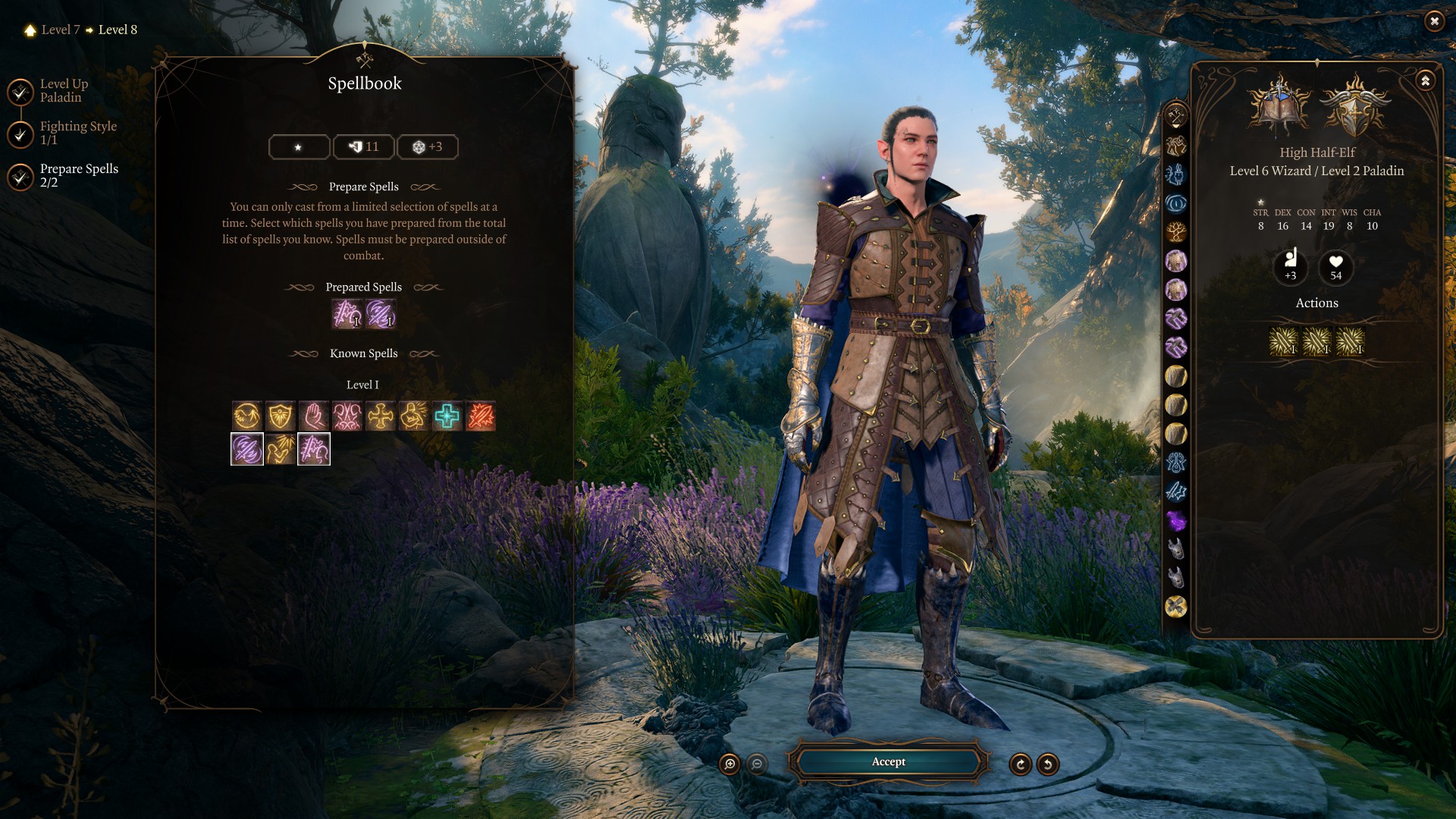
At level 8, take another level into Paladin. At this point, you can wear light armour and any weapon you want because Bladesong requires Light. However, one hand and a shield are still the best for survivability. Moreover, you gain divine smite and make sure to turn it on in the reactions menu. below are our suggestions at level eight:
- Defence Fighting Style: You gain a +1 bonus to Armour Class while wearing Armour. NOTE select great weapon fighting if you want to use 2H weapon at this point.
- Wrathful Smite: Your Weapon absorbs the wrath as you strike the target, possibly frightening the target. A target with Wrathful Smite takes 1d6 Psychic damage.
- Thunderous Smite: Your weapon rings with thunder as you strike, pushing your target 3m away and possibly knocking it Prone.
At this point, you get two smite spells. Wrathful is great with Resonance Stone a huge burst. Thunderous Smite should be used if you can get invisibility via a spell or a scroll. Then, unload on a target to trigger a surprise status effect.
Also you can use Booming Blade Cantrip as your attack WITH Shadow Blade, and trigger Divine Smite!
Level 9
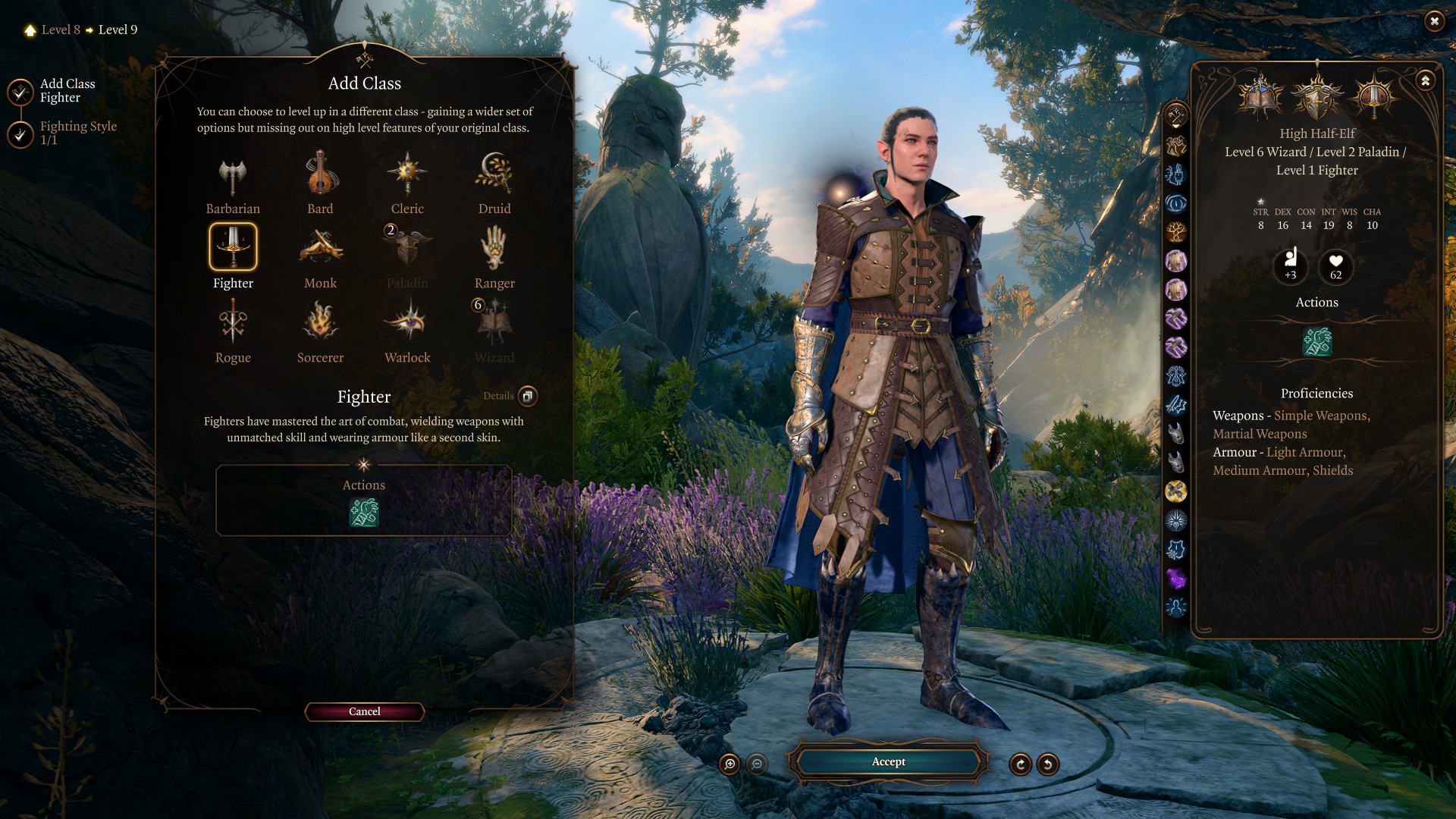
At Level 9 our Best Baldur’s Gate 3 Bladesinging Wizard Build we’re going to multiclass again, this time into the Fighter class. The reason for this is gaining Action Surge, a new sublcass, and a feat. With Action Surge, you can gain an additional action once in combat and its a huge boost to overall damage.
- Second Wind: You will receive a very powerful self-heal immediately called Second Wind. This allows you to heal yourself using a bonus action, not an action. This is very important because you can heal and attack in one turn.
- Protection Fighting Style: When you have a Shield, impose Disadvantage on an enemy who attacks one of your allies when you are within
 1.5 m / 5 ft. You must be able to see the enemy.
1.5 m / 5 ft. You must be able to see the enemy.
At level 9, the most important selection is your Fighting Style. If using two-handed, swap to Great Weapon Master selection otherwise Protection if using a shield.
Level 10

Putting a second level of Fighter in on our Level 10 Bladesinging Wizard build gives you one new skill, Action Surge.
- Action Surge: Gain one additional action. This allows the Fighter very early to take multiple actions, which will likely be attacked. This makes you formability very early in the game. Moreover, you only need a Short Rest to replenish this, which can be done twice in the bottom right of your User Interface. Take a Long Rest via camp to fill Short Rest.
Level 11

We put a third level in to Fighter for Level 11 of our Bladesinging Wizard Build, and for the subclass we want to select Champion.
Champion Subclass Unlocked: Improved Critical Hit The number you need to roll a Critical Hit while attacking is reduced by 1 and this effect can stack. The Champion subclass remains the simplest and easiest to understand. You can further reduce the critical hit dice roll, which by default is 20, even further with a item sets. Stacking means you can add more and more ways to reduce the number via feat and gear.
Keep it simple and go with Champion to make criticals easier.
Level 12
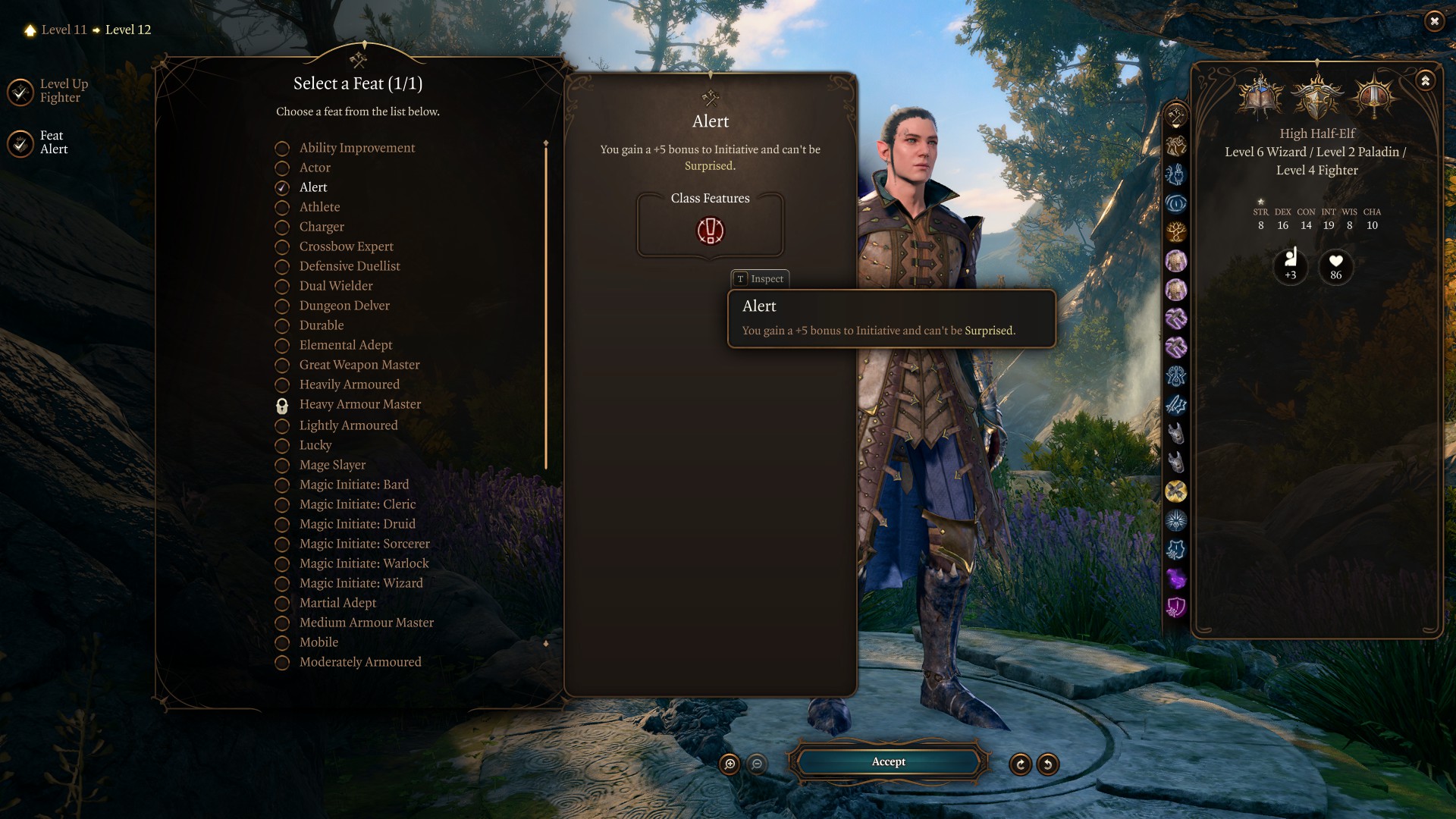
At Level 12 the Bladesinging Wizard can choose a final feat with a final level into Fighter. The best overall feat is Alert. If using Shadow Blade, Great Weapon Master and Savage Attacker will not work. If you’re using a Two-Handed weapon, then take Savage Attacker or Great Weapon Master. Stick to Alert and use Hill Giant Elixir for max strength.
How to Play the Bladesinging Wizard
The best way to play the Bladesinging Wizard is to use a high strength build with Shadow Blade and multiclass into Paladin for Divine Smite. Drink an Elixir of Cloud Giant Strength to boost your overall strength to 27. Then, use a bonus action to summon Shadow Blade, which deals psychic damage and scales off of strength. Make sure to obtain the Resonance stone in Act 2, which doubles psychic damage, including Shadow Blade. With your action, attack in melee range and trigger Divine Smites with Shadow Blade.
Below are some general tips on how to play the best Bladesinging Wizard build in BG3:
- Loot Everything: You will need a lot of gold to buy consumables, potions, and ammunition so loot and sell constantly.
- Crafting: Elixirs and potions are vital, and you need to purchase materials when trading for crafting.
- Reach Level 6: Spend the early part of the game completing every quest to reach level 6 where your power dramatically increases.
- Sell Often: Your carrying capacity will be limited so sell often, and store excessive items in your traveler’s chest.
- Stealth: Start combat in stealth if at all possible to trigger the Surprise status effect.
- Consider Illithid Powers: While it can come with an altered appearance, the powers are powerful and can help you.
- Oils + Elixiris: Combine both oils/coatings and Elixir during combat for a dual benefit.
- Persuasion: Try to avoid combat through dialogue if possible.
Best Gear for Bladesinging Wizard Build
Beginner
Here’s the best beginner gear, items, and equipment for a Bladesinging Wizard Build in Baldur’s Gate 3:
| Gear Slot | Best Gear Item | Effect |
|---|---|---|
| Head | Haste Helm | Extra Movement |
| Cape | Deathstalker Mantle (optional) | Invisibility on Kill |
| Chest | Padded Armour +2 (any Light) | Reduces Bludgeoning |
| Gloves | Gloves of the Growling Underdog | Advantage on Melee |
| Boots | Disintegrating Night Walkers | Free Misty Step |
| Necklace | Broodmother’s Revenge | 1d6 when healed |
| Ring | Strange Conduit Ring | Concenreation + Damage |
| Ring | Caustic Band | Poison Damage |
| Weapon 1 Main Hand | Phalar Aluve (Shadow Blade) | Summoned with Spell |
| Off-Hand | Adamantine Shield (If multiclass) | +2 AC |
| Weapon 2 Ranged | Bow of Awareness | +1 Initiative |
- Haste Helm: found in Blighted Village at coordinates X: 29 Y: 405 (Alternatives Cap of Wrath).
- Deathstalker Mantle: Automatically acquired as part of Dark Urge story. Optional don’t have to use.
- Padded Armour +2: sold at traders in Act 1 starting at level 5. Can use any light armour in Act 1.
- Gloves of the Growling Underdog: Chest behind Razglin’s throne room (Alternatives Gloves of Dexterity, or Gloves of Missile Snaring).
- Disintegrating Night Walkers: Obtained in Gyrmforge as part of Free True Soul Nere questline (Alternatives Boots of Striding, Boots of Genial Striding, or Boots of Speed).
- Broodmother’s Revenge: Carried by Kagha’s body in the Emerald Grove.
- Strange Conduit Ring: Crèche Y’llek X: 1360 Y: -657.
- Caustic Band: Obtained from merchant Derryth Bonecloak in the Myconid Colony (Alternatives Fetish of Callarduran Smoothhands, or The Sparkswall).
- Phalar Aluve: Found in Underdark at coordinates X: 116 Y: -192 (keep Shadow Blade in your head or Phalar).
- Adamantine Shield: Crafted in Adamantine Forge.
- Bow of Awareness: Sold by Vendor Roah Moonglow in the Shattered Sanctum (Alternatives Hunting Shortbow, Bow of Banshee, Titanstring Bow).
Advanced
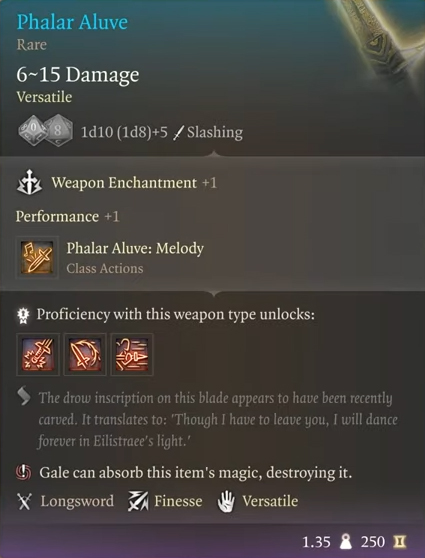
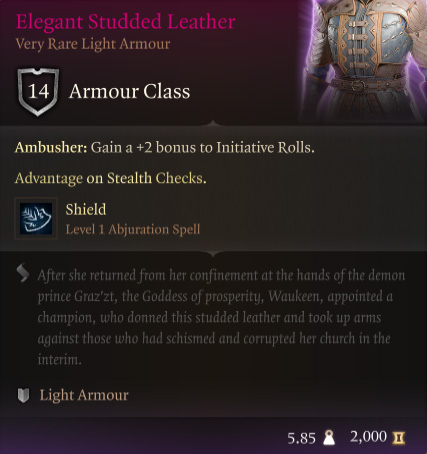

The following table presents the best gear, items, and equipment for the Bladesinging Wizard Build in Baldur’s Gate 3:
| Gear Slot | Best Gear Item | Effect |
|---|---|---|
| Head | Mask of Soul Perception | +2 Attack Roll |
| Cape | Deathstalker Mantle | Invisibility on Kill |
| Chest | Elegant Studded Leather | Shield Spell Light Armour |
| Gloves | Craterflesh Gloves | Crits + Damage |
| Boots | Helldusk Boots | Mobility |
| Necklace | Amulet of Greater Health | 23 Constitution |
| Ring | Killer’s Sweetheart | Auto Critical |
| Ring | Strange Conduit Ring | Self-healing |
| Weapon 1 Main Hand | Phalar Aluve | + Movement |
| Off-Hand | Viconia’s Walking Fortress | +3 AC |
| Weapon 2 Ranged | Hellriders | +3 initiative |
| Misc | Resonance Stone | Double Psychic Damage |
List of best Bladesinging Wizard Build Baldur’s Gate 3 Equipment in the end-game:
- Mask of Soul Perception: Obtained in Devil’s Fee (Alternatives Helldusk Helmet, Sarevok’s Horned Helmet).
- Deathstalker Mantle: Automatically acquired as part of Dark Urge story. (Alternatives Cloak of Protection).
- Elegant Studded Leather: Counting House Vault (Use Bhaalist Armour with Crimson Mischief)
- Craterflesh Gloves: murder tribunal vendor (Alternatives Gauntlets of Hill Giant Strength, Helldusk Gloves)
- Helldusk Boots: In a locked chest, Wyrm’s Rock Fortress (Alternative Disintegrating Night Walkers).
- Amulet of Greater Health: Obtained in Archive of the House of Hope (Alternative Surgeon’s Subjugation Amulet).
- Killer’s Sweetheart: Obtained from the Gauntlet of Shar in Act 2 (Alternative Ring of Protection, Risky Ring).
- Strange Conduit Ring: Crèche Y’llek X: 1360 Y: -657 (Alternative Ring of Free Action, Shifting Corpus Ring).
- Phalar Aluve: Found in Underdark at coordinates X: 116 Y: -192 (use Shadow Blade in main hand, if not can also do Bhaalist Armour with Crimson Mischief).
- Viconia’s Walking Fortress: Complete Shadowheart’s Quest Daughter of Darkness.
- Hellriders: Rivington X: 43 Y: -101: Sold by Ferg (Alternative darkfire shortbow).
- Resonance Stone: End of act 2 in puzzle mind flayer colony.
Best Tips and Tricks for Bladesinging Wizard Build
The best tip when playing the Bladesinging Wizard build is to pre-buff with spells like Mirror Image, Shadow Blade, and Elixir of Hill Giant Strength. Next, crouch to enter stealth and start combat with Thunderous Smite to trigger a surprise status effect. From this point, use your actions for melee attacks and trigger divine smite to trigger extra damage. Use your bonus action for misty step and potions or consumables.
Best Consumables, Potions, Ammunition, and Items
The following list is the best consumable items that will aid in our Best Baldur’s Gate 3 Bladesinging Wizard Build Guide:
- Elixir of Bloodlust: Once per turn when you kill a foe, you gain HP 5 temporary hit points and an additional action.
- Elixir of Hill Giant Strength: Increases Strength ability score to 21 until Long Rest.
- Potion of Speed: Gain extra action, +2 AC, Advantage on Dexterity Saving Throws, and double movement speed.
- Drow Poison: Weapon poison that adds Constitution Saving Throw or becomes Poisoned and falls Asleep.
- Potion of Flying: Drink to gain a flying speed of 60ft for one hour.
- Elixir of Heroism: Gain 10 temp HP and become Blessed until a long rest.
- Potion of Greater Healing: 4d4 + 4 hit points restored.
- Oil of Accuracy: Coat Weapon. Bonus of +2 in Attack Rolls.
- Elixir of Vigilance: Drink to gain a +5 bonus to Initiative and you can’t be Surprised.
Permanent Bonuses
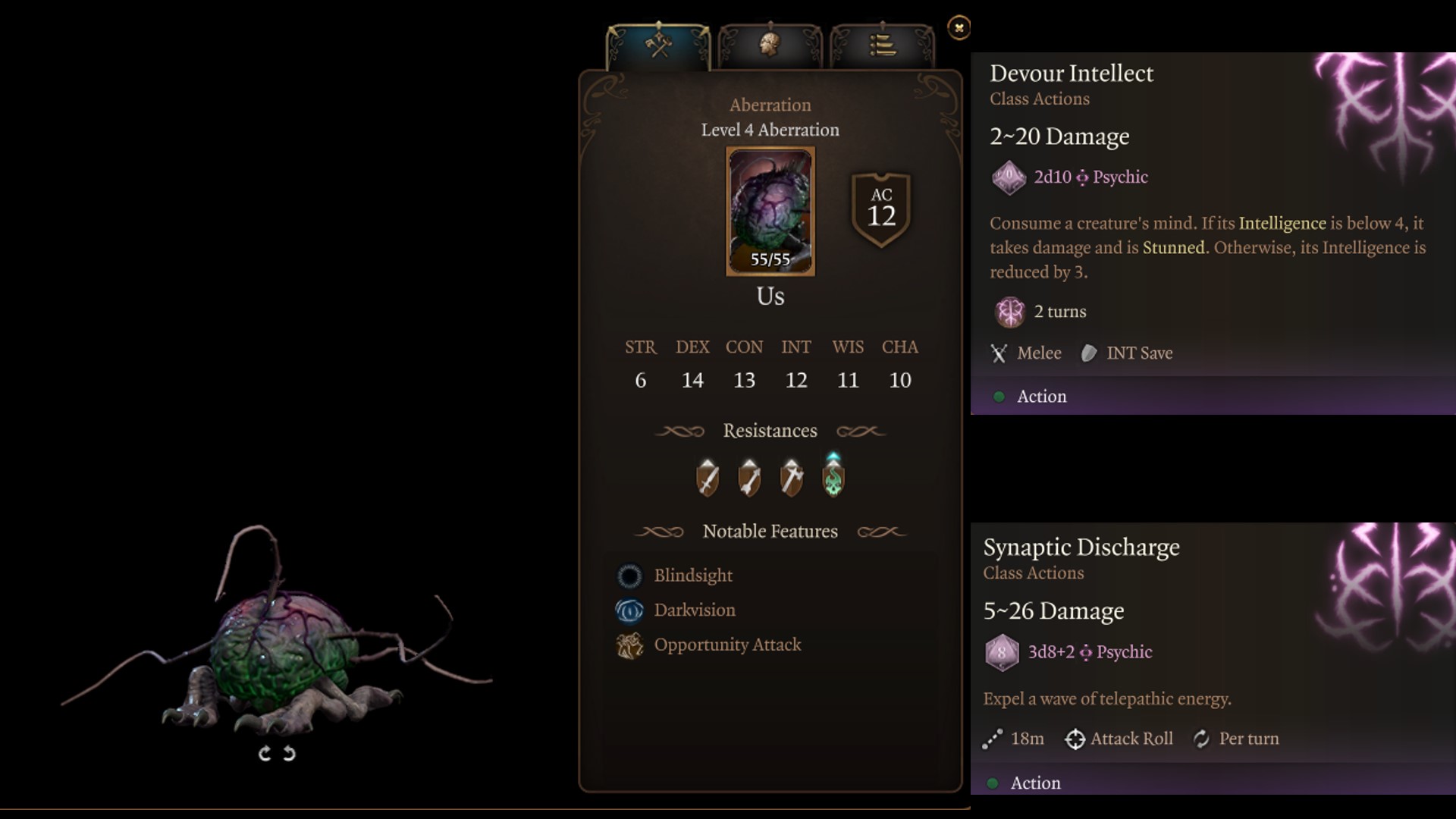
Throughout Baldur’s Gate 3, you will have the ability to gain permanent bonuses to your character. These can grant additional spells, ability scores, and other bonuses. Permanent Bonuses are not displayed throughout the campaign but are vital to increase overall combat performance. We have all permanent bonuses here in a guide, but the most important ones for you to collect are listed below.
| Act 1 | Act 2 | Act 3 |
|---|---|---|
| Auntie Ethel’s Hair: Gain +1 to an Ability Score. | Potion of Everlasting Vigour: Gain +2 Strength. | Mirror of Loss – +2 to an Ability Score of your choice. |
| Awakened: Use illithid powers as a Bonus Action. | Slayer Form: Ability to transform into the Slayer. | Partial Ceremorphosis: Access to tier 3 illithid Powers. |
| Scratch: Gain Find Familiar Scratch. | Summon Us: Allows you to summon Us. | Sweet Stone Features: Blessed permanent. |
| Cheeky Quasit: Gain Summon Quasit Shovel. | Statue of the Gods: +2 to Saving Throws | |
| Loviatar’s Love: 30% Hit Points or less, you gain a +2 bonus to Attack Rolls and Wisdom saving throws. | ||
| Necromancy Of Thay: access to powerful spells in Act 3. | ||
| Volo’s Ersatz Eye: See Invisibility |
Bladesinging Wizard Changes in Patch 8 for BG3
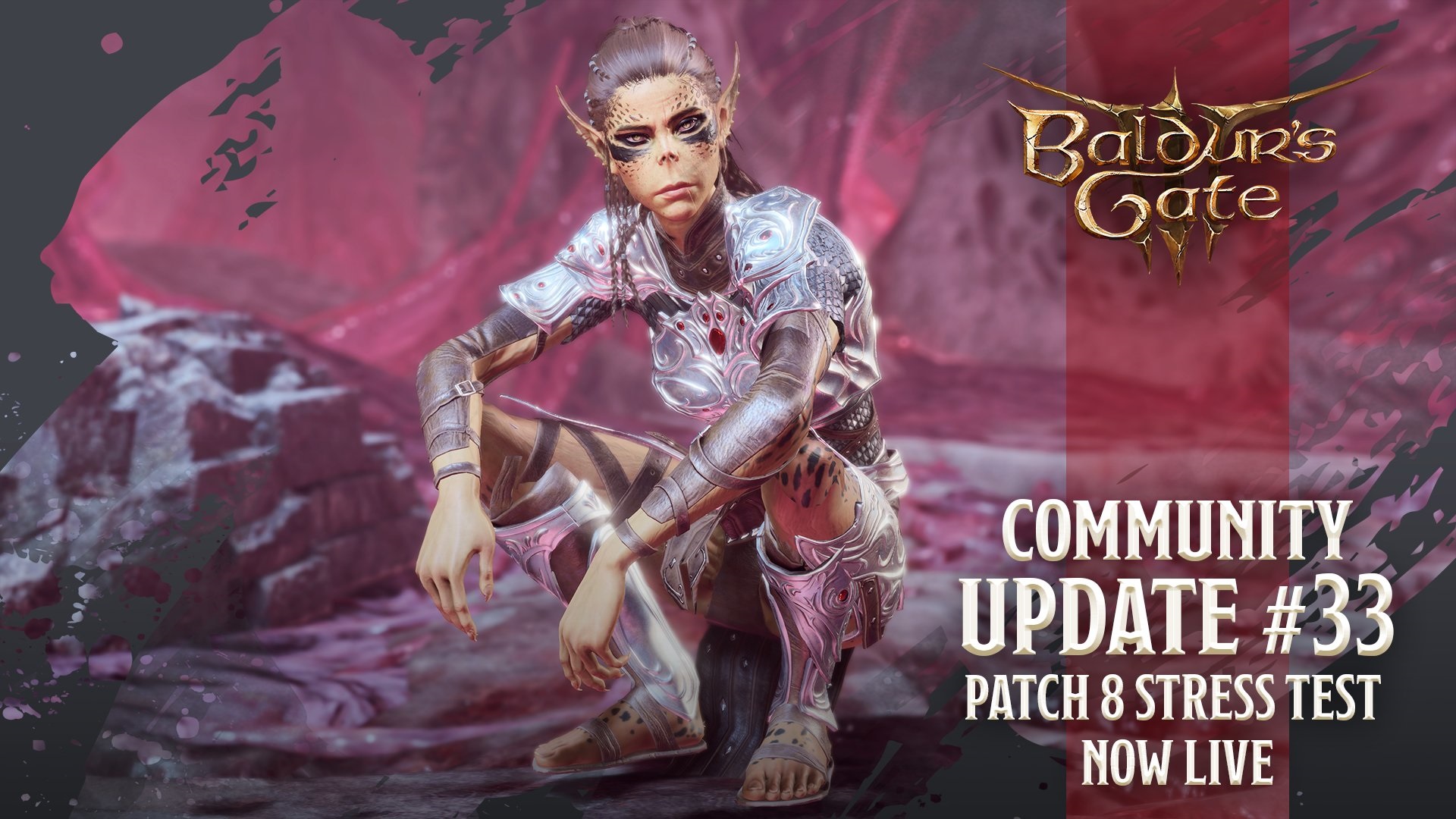
Baldur’s Gate 3 Patch 8 brings 12 new subclasses including the Bladesinging Wizard. This subclass is focused on melee damage, and also introduces new spell Shadow Blade, and Cantrip Booming Blade. This update single-handedly gives the Wizard a viable melee burst damage that can rival Barbarian’s Paladin’s and Fighter’s.
Build Summary – Best Baldur’s Gate 3 Wizard Bladesinging
Class – Wizard
Subclasses – Bladesinging
Armor – Light
Weapons: One hand and a Shield
Race – High Half-Elf
Ability Score
- Strength – 8
- Dexterity – 16
- Constitution – 14
- Intelligence – 17
- Wisdom – 8
- Charisma – 10
Level Progression
- Level 1 – Fire Bolt, Booming Blade, Bursting Sinew, Friends, Longstrider, Shield, Thunderwave, Magic Missile
- Level 2 – Subclass: Bladesinging, False Life, Feather Fall
- Level 3 – Shadow Blade, Misty Step
- Level 4 – Feat: Ability Improvement +2, Blur, Mirror Image
- Level 5 – Fireball, Counterspell
- Level 6 – Extra Attack, Darkness, Enlarge/Reduce
- Level 7 – Multiclass: Oath of Devotion Paladin
- Level 8 – Defence Fighting Style, Command, Thunderous Smite
- Level 9 – Multiclass: Fighter, Protection Fighting Style
- Level 10 – Surge
- Level 11 – Subclass: Champion
- Level 12 – Feat: Alert
FAQs about the Bladesinging Wizard build in Baldur’s Gate 3
What abilities should the Bladesinging Wizard prioritize for my class?
The most important ability scores are Intelligence and Dexterity for the Bladesinging Wizard. If playing in melee range with Shadow Blade, use strength via the Elixir of Hill Giant Strength to increase overall damage.
What are the best feats for Bladesinging Wizard builds?
Savage Attackers, Alert, and Ability Improvement are the best feats for the Bladesinging Wizard. Savage Attacker works with the Shadow Blade spell and dramatically increase your melee damage.
What are the best multiclass combos?
The best multiclass combos for the Bladesinging Wizard are with a Paladin and Fighter. The Paladin gives the Wizard Divine Smites, triggering extra damage on melee hits. While the Fighter grants the Wizard Action Surge, giving ane extra action once per combat.
Are there “must-have” items for Bladesinging Wizard builds?
Hellriders Longbow, Resonance Stone, and Craterflesh Gloves are must-have items for the Bladesinging Wizard build. The Hellriders Longbow gives +3 initiative, ensuring your Wizard goes first or second in combat order. The Resonance Stone doubles psychic damage, making your Shadow Blade spell twice as effective. Lastly, the Craterflesh Gloves doubles critical damage and is helpful when using the Champion subclass reducing critical rolls.
Looking For More About Baldur’s Gate 3?
Thank you for reading Best Baldur’s Gate 3 Bladesinging Wizard Build guide. We provide the latest news and create guides for Baldur’s Gate 3. Also, watch me play games on Twitch or visit my YouTube channel!
 Reddit
Reddit
 Email
Email
